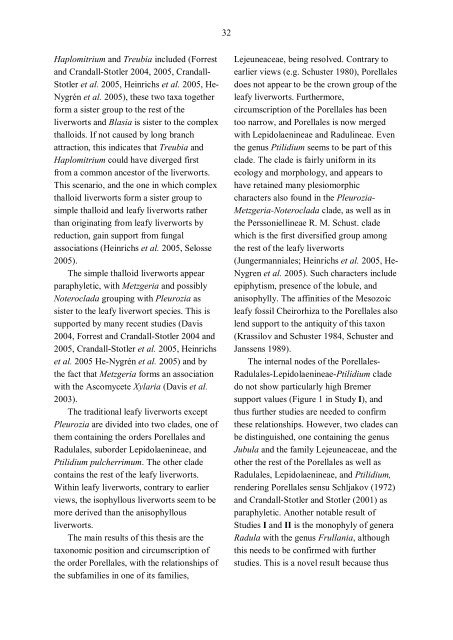Evolutionary relationships of liverworts with a special focus ... - Doria
Evolutionary relationships of liverworts with a special focus ... - Doria
Evolutionary relationships of liverworts with a special focus ... - Doria
Create successful ePaper yourself
Turn your PDF publications into a flip-book with our unique Google optimized e-Paper software.
32<br />
Haplomitrium and Treubia included (Forrest<br />
and Crandall-Stotler 2004, 2005, Crandall-<br />
Stotler et al. 2005, Heinrichs et al. 2005, He-<br />
Nygrén et al. 2005), these two taxa together<br />
form a sister group to the rest <strong>of</strong> the<br />
<strong>liverworts</strong> and Blasia is sister to the complex<br />
thalloids. If not caused by long branch<br />
attraction, this indicates that Treubia and<br />
Haplomitrium could have diverged first<br />
from a common ancestor <strong>of</strong> the <strong>liverworts</strong>.<br />
This scenario, and the one in which complex<br />
thalloid <strong>liverworts</strong> form a sister group to<br />
simple thalloid and leafy <strong>liverworts</strong> rather<br />
than originating from leafy <strong>liverworts</strong> by<br />
reduction, gain support from fungal<br />
associations (Heinrichs et al. 2005, Selosse<br />
2005).<br />
The simple thalloid <strong>liverworts</strong> appear<br />
paraphyletic, <strong>with</strong> Metzgeria and possibly<br />
Noteroclada grouping <strong>with</strong> Pleurozia as<br />
sister to the leafy liverwort species. This is<br />
supported by many recent studies (Davis<br />
2004, Forrest and Crandall-Stotler 2004 and<br />
2005, Crandall-Stotler et al. 2005, Heinrichs<br />
et al. 2005 He-Nygrén et al. 2005) and by<br />
the fact that Metzgeria forms an association<br />
<strong>with</strong> the Ascomycete Xylaria (Davis et al.<br />
2003).<br />
The traditional leafy <strong>liverworts</strong> except<br />
Pleurozia are divided into two clades, one <strong>of</strong><br />
them containing the orders Porellales and<br />
Radulales, suborder Lepidolaenineae, and<br />
Ptilidium pulcherrimum. The other clade<br />
contains the rest <strong>of</strong> the leafy <strong>liverworts</strong>.<br />
Within leafy <strong>liverworts</strong>, contrary to earlier<br />
views, the isophyllous <strong>liverworts</strong> seem to be<br />
more derived than the anisophyllous<br />
<strong>liverworts</strong>.<br />
The main results <strong>of</strong> this thesis are the<br />
taxonomic position and circumscription <strong>of</strong><br />
the order Porellales, <strong>with</strong> the <strong>relationships</strong> <strong>of</strong><br />
the subfamilies in one <strong>of</strong> its families,<br />
Lejeuneaceae, being resolved. Contrary to<br />
earlier views (e.g. Schuster 1980), Porellales<br />
does not appear to be the crown group <strong>of</strong> the<br />
leafy <strong>liverworts</strong>. Furthermore,<br />
circumscription <strong>of</strong> the Porellales has been<br />
too narrow, and Porellales is now merged<br />
<strong>with</strong> Lepidolaenineae and Radulineae. Even<br />
the genus Ptilidium seems to be part <strong>of</strong> this<br />
clade. The clade is fairly uniform in its<br />
ecology and morphology, and appears to<br />
have retained many plesiomorphic<br />
characters also found in the Pleurozia-<br />
Metzgeria-Noteroclada clade, as well as in<br />
the Perssoniellineae R. M. Schust. clade<br />
which is the first diversified group among<br />
the rest <strong>of</strong> the leafy <strong>liverworts</strong><br />
(Jungermanniales; Heinrichs et al. 2005, He-<br />
Nygren et al. 2005). Such characters include<br />
epiphytism, presence <strong>of</strong> the lobule, and<br />
anisophylly. The affinities <strong>of</strong> the Mesozoic<br />
leafy fossil Cheirorhiza to the Porellales also<br />
lend support to the antiquity <strong>of</strong> this taxon<br />
(Krassilov and Schuster 1984, Schuster and<br />
Janssens 1989).<br />
The internal nodes <strong>of</strong> the Porellales-<br />
Radulales-Lepidolaenineae-Ptilidium clade<br />
do not show particularly high Bremer<br />
support values (Figure 1 in Study I), and<br />
thus further studies are needed to confirm<br />
these <strong>relationships</strong>. However, two clades can<br />
be distinguished, one containing the genus<br />
Jubula and the family Lejeuneaceae, and the<br />
other the rest <strong>of</strong> the Porellales as well as<br />
Radulales, Lepidolaenineae, and Ptilidium,<br />
rendering Porellales sensu Schljakov (1972)<br />
and Crandall-Stotler and Stotler (2001) as<br />
paraphyletic. Another notable result <strong>of</strong><br />
Studies I and II is the monophyly <strong>of</strong> genera<br />
Radula <strong>with</strong> the genus Frullania, although<br />
this needs to be confirmed <strong>with</strong> further<br />
studies. This is a novel result because thus
















